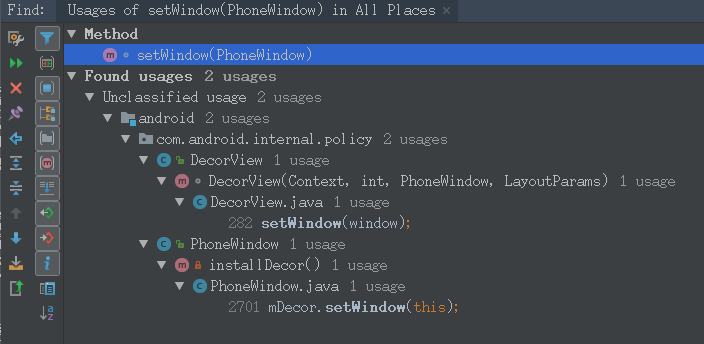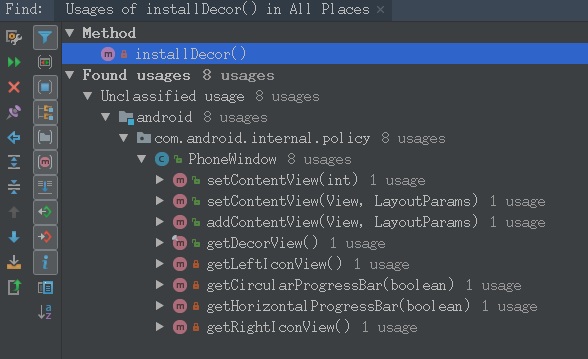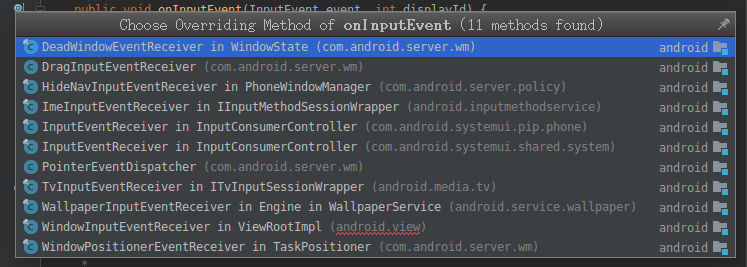一、 摘要
介绍Android中View的事件分发流程,以及对事件的消费和拦截。本文基于Android 8.0(Oreo),即API 26。
二、 View的事件
View有四种基本事件,它们位于MotionEvent中:
- ACTION_DOWN:按压动作开始的标志,事件中包含这个初始位置。
- ACTION_UP:按压结束的标志,事件中包含这个结束位置。
- ACTION_MOVE:按压松开之前的状态,事件中包含当前运动位置。
- ACTION_CANCEL:手势取消了,你应该类比ACTION_UP来处理。
当我们在View上进行交互时,首先硬件层屏幕传感器捕获这些信息,然后通过很复杂的流程传递到Android应用层,即传到我们的Activity中,以事件的形式向下分发到各层的View中进行处理。
三、 分发涉及的三个核心方法
1. 概述
View的事件分发流程涉及到三个核心方法:dispatchTouchEvent()、onTouchEvent()和onInterceptTouchEvent(),这三个方法将事件在Activity、Window、DecorView、ViewGroup、View之间传递。
通过前两章(《Android中View的绘制流程》、《Android中View的异步消息》)的学习,我们知道了Window、ViewRootImpl、DecorView、ViewGroup、View之间的关系,在源码中,Window只有唯一实现类——PhoneWindow:
/**
* <p>The only existing implementation of this abstract class is
* android.view.PhoneWindow, which you should instantiate when needing a
* Window.
*/
public abstract class Window {...}
根据这些知识,我们能够更快地理解事件分发流程。
接下来我们先介绍这三个方法。
- dispatchTouchEvent()存在于Activity、ViewGroup、View中;
- onTouchEvent()也存在于Activity、ViewGroup、View中;
- onInterceptTouchEvent()仅存在于ViewGroup中。
即:
| 组件 \ 方法 | dispatchTouchEvent | onTouchEvent | onInterceptTouchEvent |
|---|---|---|---|
| Activity | YES | YES | |
| View | YES | YES | |
| ViewGroup | YES | YES | YES |
从字面意思上看,dispatchTouchEvent和分发触摸事件有关,onTouchEvent和执行触摸事件有关,onInterceptTouchEvent和拦截触摸事件有关。
2. Activity中
2.1. dispatchTouchEvent()
/**
* Called to process touch screen events. You can override this to
* intercept all touch screen events before they are dispatched to the
* window. Be sure to call this implementation for touch screen events
* that should be handled normally.
*
* @param ev The touch screen event.
*
* @return boolean Return true if this event was consumed.
*/
public boolean dispatchTouchEvent(MotionEvent ev) {...}
- 用于处理触屏事件。
- 你可以重写这个方法来拦截所有的触屏事件,不让他们分发到Window。
- 通常情况下你应该调用这里的具体实现去处理触屏事件。
- 如果事件被消费了,返回true。
2.2. onTouchEvent()
/**
* Called when a touch screen event was not handled by any of the views
* under it. This is most useful to process touch events that happen
* outside of your window bounds, where there is no view to receive it.
*
* @param event The touch screen event being processed.
*
* @return Return true if you have consumed the event, false if you haven't.
* The default implementation always returns false.
*/
public boolean onTouchEvent(MotionEvent event) {...}
- 当一个触屏事件没有被这个Activity下的任何View处理时,调用该方法。
- 该方法最大的用处是去处理Window边界以外,没有View去响应的触屏事件。
- 如果事件被消费了,返回true。默认返回false。
3. View中
3.1. dispatchTouchEvent()
/**
* Pass the touch screen motion event down to the target view, or this
* view if it is the target.
*
* @param event The motion event to be dispatched.
* @return True if the event was handled by the view, false otherwise.
*/
public boolean dispatchTouchEvent(MotionEvent event) {...}
- 将触屏事件向下传递到目标视图,如果当前视图就是目标,则传递到当前视图。
- 如果事件被处理了,返回true。
3.2. onTouchEvent()
/**
* Implement this method to handle touch screen motion events.
* <p>
* If this method is used to detect click actions, it is recommended that
* the actions be performed by implementing and calling
* {@link #performClick()}. This will ensure consistent system behavior,
* including:
* <ul>
* <li>obeying click sound preferences
* <li>dispatching OnClickListener calls
* <li>handling {@link AccessibilityNodeInfo#ACTION_CLICK ACTION_CLICK} when
* accessibility features are enabled
* </ul>
*
* @param event The motion event.
* @return True if the event was handled, false otherwise.
*/
public boolean onTouchEvent(MotionEvent event) {...}
- 该方法用于处理触屏事件。
- 如果想用这个方法来监听点击动作,建议实现并调用performClick()。这将确保系统行为一致性,包括:遵守点击声音首选项、分发OnClickListener、处理ACTION_CLICK。
- 如果事件被处理了,返回true。
4. ViewGroup中
4.1. dispatchTouchEvent()
重写了View中的实现。
4.2. onTouchEvent()
继承View中的方法。
4.3. onInterceptTouchEvent()
/**
* Implement this method to intercept all touch screen motion events. This
* allows you to watch events as they are dispatched to your children, and
* take ownership of the current gesture at any point.
*
* <p>Using this function takes some care, as it has a fairly complicated
* interaction with {@link View#onTouchEvent(MotionEvent)
* View.onTouchEvent(MotionEvent)}, and using it requires implementing
* that method as well as this one in the correct way. Events will be
* received in the following order:
*
* <ol>
* <li> You will receive the down event here.
* <li> The down event will be handled either by a child of this view
* group, or given to your own onTouchEvent() method to handle; this means
* you should implement onTouchEvent() to return true, so you will
* continue to see the rest of the gesture (instead of looking for
* a parent view to handle it). Also, by returning true from
* onTouchEvent(), you will not receive any following
* events in onInterceptTouchEvent() and all touch processing must
* happen in onTouchEvent() like normal.
* <li> For as long as you return false from this function, each following
* event (up to and including the final up) will be delivered first here
* and then to the target's onTouchEvent().
* <li> If you return true from here, you will not receive any
* following events: the target view will receive the same event but
* with the action {@link MotionEvent#ACTION_CANCEL}, and all further
* events will be delivered to your onTouchEvent() method and no longer
* appear here.
* </ol>
*
* @param ev The motion event being dispatched down the hierarchy.
* @return Return true to steal motion events from the children and have
* them dispatched to this ViewGroup through onTouchEvent().
* The current target will receive an ACTION_CANCEL event, and no further
* messages will be delivered here.
*/
public boolean onInterceptTouchEvent(MotionEvent ev) {...}
- 用于拦截所有的触屏事件。
- 这使你可以在事件被分发到子视图时进行监听,并且在任何时候把控当前手势。
- 使用时需要当心,因为它和onTouchEvent()的交互相当复杂,你得以正确的方式来实现这个方法。
- 按这个顺序接收事件:(1)接收down事件。(2)既可以用这个ViewGroup的子视图,也可以用onTouchEvent()这个方法来处理down事件,这意味着你应该实现onTouchEvent()这个方法并返回true,这样你将看到手势的剩余部分(不要用父视图来处理它)。同样,通过在onTouchEvent()中返回true,你就不会在onInterceptTouchEvent()中收到任何后续事件,并且所有的触摸处理只能在onTouchEvent()中正常进行。(3)只要你从这返回false,接下来的每个事件(直到并包括最终的up事件)都将首先传递到这里,然后传递给目标的onTouchEvent()。(4)如果你从这返回true,你将接收不到以下事件:目标视图会接收相同的事件但是带着ACTION_CANCEL动作,所有其他事件将被传递到onTouchEvent()方法,不再出现在这里。
- 返回true来拦截来自子视图的事件,通过onTouchEvent()来分发它们。当前目标将接收一个ACTION_CANCEL事件,并且此处不会再传递更多的消息。
四、 事件分发流程
看完了三个核心方法的注释,被一大堆布尔返回值搞懵了,那么我们从方法调用栈下手,分析事件分发的具体流程,分析过程中,我们除了要关注向下传递的事件,还要关注向上传递的返回值,这比一般的方法调用要复杂一些。
在开始介绍流程前,还得搞明白两个术语:消费和拦截。
1. 什么是消费
事件被消费,即事件被处理,也就是onTouchEvent()这个方法中的执行情况,因为Activity、ViewGroup和View中都有onTouchEvent(),所以我们将在它们三个中分别介绍消费的情况。
2. 什么是拦截
拦截,顾名思义,截断事件的传递过程,当事件被拦截后,无法再向下分发,由于拦截的方法onInterceptTouchEvent()仅存于ViewGroup中,因此我们只会在ViewGroup中分析拦截过程。
3. Activity中的流程
我们先从Activity的入口——dispatchTouchEvent()开始分析,至于这个入口又是谁在调用,我们调一下顺序,放在后面来介绍。(因为一般情况下,我们只需要研究从Activity这里开始的内容,至于事件的来源,涉及到native部分)
/**
* 分发
*/
public boolean dispatchTouchEvent(MotionEvent ev) {
// 事件开始的标志:ACTION_DOWN
if (ev.getAction() == MotionEvent.ACTION_DOWN) {
// 你可以重写这个方法,来得知用户用什么方式进行的交互
onUserInteraction();
}
// 将事件分发给Window,如果它消费了,此处也就返回true表示消费了
if (getWindow().superDispatchTouchEvent(ev)) {
return true;
}
// Window没消费这个事件的话,Activity就自己来处理,并返回消费情况
return onTouchEvent(ev);
}
/**
* 消费
*/
public boolean onTouchEvent(MotionEvent event) {
// 如果需要关闭Window,即结束Activity,就结束,并返回true表示消费了
if (mWindow.shouldCloseOnTouch(this, event)) {
finish();
return true;
}
return false;
}
/**
* 位于Window类中的shouldCloseOnTouch()
* 主要是根据事件是否出界来判断是否需要关闭
*/
public boolean shouldCloseOnTouch(Context context, MotionEvent event) {
final boolean isOutside =
event.getAction() == MotionEvent.ACTION_DOWN && isOutOfBounds(context, event)
|| event.getAction() == MotionEvent.ACTION_OUTSIDE;
if (mCloseOnTouchOutside && peekDecorView() != null && isOutside) {
return true;
}
return false;
}
Activity将事件分发到了Window中,而Window唯一实现类是PhoneWindow,我们直接去PhoneWindow中看此处方法:
@Override
public boolean superDispatchTouchEvent(MotionEvent event) {
return mDecor.superDispatchTouchEvent(event);
}
PhoneWindow将事件分发给了DecorView:
public boolean superDispatchTouchEvent(MotionEvent event) {
return super.dispatchTouchEvent(event);
}
DecorView将事件分发给了父类,我们知道DecorView是继承ViewGroup的,因此这里又将事件分发到了ViewGroup中。
由此可得:
- Activity中,事件被分发到ViewGroup,并返回消费结果。
- 如果ViewGroup返回的消费结果是false,则由Activity自己消费并返回结果。
4. ViewGroup中的流程
/**
* 分发
*/
@Override
public boolean dispatchTouchEvent(MotionEvent ev) {
// ...
// 事件是否被消费
boolean handled = false;
// ...
final int actionMasked = action & MotionEvent.ACTION_MASK;
// Handle an initial down.
if (actionMasked == MotionEvent.ACTION_DOWN) {
// Throw away all previous state when starting a new touch gesture.
// The framework may have dropped the up or cancel event for the previous gesture
// due to an app switch, ANR, or some other state change.
cancelAndClearTouchTargets(ev);
// 此处会将mFirstTouchTarget置空
resetTouchState();
}
// 事件是否被拦截
// Check for interception.
final boolean intercepted;
// ACTION_DOWN是事件开始标志,因此在ACTION_DOWN情况下判断拦截
if (actionMasked == MotionEvent.ACTION_DOWN
|| mFirstTouchTarget != null) {
final boolean disallowIntercept = (mGroupFlags & FLAG_DISALLOW_INTERCEPT) != 0;
if (!disallowIntercept) {
// 由拦截方法返回值判断是否被拦截
intercepted = onInterceptTouchEvent(ev);
ev.setAction(action); // restore action in case it was changed
} else {
intercepted = false;
}
} else {
// There are no touch targets and this action is not an initial down
// so this view group continues to intercept touches.
intercepted = true;
}
// ...
// 如果不取消也不拦截,则向下分发
if (!canceled && !intercepted) {
// ...
// 遍历子View,并寻找事件坐标在界限内的最上层一个子View来分发
final View[] children = mChildren;
for (int i = childrenCount - 1; i >= 0; i--) {
final int childIndex = getAndVerifyPreorderedIndex(
childrenCount, i, customOrder);
final View child = getAndVerifyPreorderedView(
preorderedList, children, childIndex);
// ...
// 根据子View分发
if (dispatchTransformedTouchEvent(ev, false, child, idBitsToAssign)) {
// ...
// 此处对mFirstTouchTarget实例化
newTouchTarget = addTouchTarget(child, idBitsToAssign);
alreadyDispatchedToNewTouchTarget = true;
break;
}
// ...
}
// ...
}
// Dispatch to touch targets.
if (mFirstTouchTarget == null) {
// 根据子View分发
// No touch targets so treat this as an ordinary view.
handled = dispatchTransformedTouchEvent(ev, canceled, null,
TouchTarget.ALL_POINTER_IDS);
} else {
// Dispatch to touch targets, excluding the new touch target if we already
// dispatched to it. Cancel touch targets if necessary.
TouchTarget predecessor = null;
TouchTarget target = mFirstTouchTarget;
// 循环对子View进行分发,不包括刚才已经分发过的那个
while (target != null) {
final TouchTarget next = target.next;
if (alreadyDispatchedToNewTouchTarget && target == newTouchTarget) {
handled = true;
} else {
final boolean cancelChild = resetCancelNextUpFlag(target.child)
|| intercepted;
// 根据子View分发
if (dispatchTransformedTouchEvent(ev, cancelChild,
target.child, target.pointerIdBits)) {
handled = true;
}
// ...
}
predecessor = target;
target = next;
}
}
if (canceled
|| actionMasked == MotionEvent.ACTION_UP
|| actionMasked == MotionEvent.ACTION_HOVER_MOVE) {
// 此处会将mFirstTouchTarget置空
resetTouchState();
}
// ...
return handled;
}
/**
* 拦截
*/
public boolean onInterceptTouchEvent(MotionEvent ev) {
if (ev.isFromSource(InputDevice.SOURCE_MOUSE)
&& ev.getAction() == MotionEvent.ACTION_DOWN
&& ev.isButtonPressed(MotionEvent.BUTTON_PRIMARY)
&& isOnScrollbarThumb(ev.getX(), ev.getY())) {
return true;
}
return false;
}
private boolean dispatchTransformedTouchEvent(MotionEvent event, boolean cancel,
View child, int desiredPointerIdBits) {
final boolean handled;
// ...
if (child == null) {
// 没有子View的话,调用父类(即View)的分发方法,并将结果作为消费结果返回
handled = super.dispatchTouchEvent(transformedEvent);
} else {
// 有子View的话,调用子View的分发方法,并将结果作为消费结果返回
handled = child.dispatchTouchEvent(transformedEvent);
}
// ...
return handled;
}
/**
* 位于View类中的dispatchTouchEvent()
* 由于ViewGroup没有重写onTouchEvent(),因此实际上消费的逻辑还是使用的View的消费逻辑
*/
public boolean dispatchTouchEvent(MotionEvent event) {
// ...
// 消费的结果
boolean result = false;
// ...
if (!result && onTouchEvent(event)) {
result = true;
}
// ...
return result;
}
/**
* 在子View中遍历到目标,则加到链表头部,并且将mFirstTouchTarget实例化
*/
private TouchTarget addTouchTarget(@NonNull View child, int pointerIdBits) {
final TouchTarget target = TouchTarget.obtain(child, pointerIdBits);
target.next = mFirstTouchTarget;
mFirstTouchTarget = target;
return target;
}
整理一下整个过程:
- Activity将事件分发到DecorView(本身也是ViewGroup)的dispatchTouchEvent()。
- ViewGroup先判断事件拦截onInterceptTouchEvent(),如果不拦截,找到目标子View(ViewGroup或者View对象)进行分发,并返回消费结果。
- 如果拦截了,则不再向下分发,而是由ViewGroup自己消费,并返回结果。
- 可能有读者没看明白为什么不拦截最后调用的是super.dispatchTouchEvent(),在dispatchTouchEvent()中有两处调用resetTouchState()来将mFirstTouchTarget置空,因此每次进入dispatchTouchEvent()时,mFirstTouchTarget都为null,只有当不拦截时,才会进入循环体去找到目标子View,并且将mFirstTouchTarget实例化。
5. View中的流程
/**
* 分发
*/
public boolean dispatchTouchEvent(MotionEvent event) {
// ...
// 消费的结果
boolean result = false;
// ...
if (!result && onTouchEvent(event)) {
result = true;
}
// ...
return result;
}
/**
* 消费
*/
public boolean onTouchEvent(MotionEvent event) {
// ...
final boolean clickable = ((viewFlags & CLICKABLE) == CLICKABLE
|| (viewFlags & LONG_CLICKABLE) == LONG_CLICKABLE)
|| (viewFlags & CONTEXT_CLICKABLE) == CONTEXT_CLICKABLE;
// ...
if (clickable || (viewFlags & TOOLTIP) == TOOLTIP) {
switch (action) {
case MotionEvent.ACTION_UP:
// ...
case MotionEvent.ACTION_DOWN:
// ...
case MotionEvent.ACTION_CANCEL:
// ...
case MotionEvent.ACTION_MOVE:
// ...
}
return true;
}
return false;
}
/**
* 指示此视图可在悬停或长按下时显示工具提示。
* <p>Indicates this view can display a tooltip on hover or long press.</p>
* {@hide}
*/
static final int TOOLTIP = 0x40000000;
View的情况比较简单,很容易理解:
- View作为基类不能再向下分发了,只能消费。
- 如果当前View可点击,就处理事件,并返回true作为消费结果。
6. Activity中事件来源
Activity中事件来源,也就是谁调用了dispatchTouchEvent(),我们查看方法栈,发现在DecorView中:
@Override
public boolean dispatchTouchEvent(MotionEvent ev) {
// ...
final Window.Callback cb = mWindow.getCallback();
return cb != null && !mWindow.isDestroyed() && mFeatureId < 0
? cb.dispatchTouchEvent(ev) : super.dispatchTouchEvent(ev);
}
Activity这个类是实现了Window.Callback接口的,因此事件从这里分发到Activity的dispatchTouchEvent()。接下来我们先看看这个mWindow的来源,再去追踪事件的来源:
void setWindow(PhoneWindow phoneWindow) {
mWindow = phoneWindow;
Context context = getContext();
if (context instanceof DecorContext) {
DecorContext decorContext = (DecorContext) context;
decorContext.setPhoneWindow(mWindow);
}
}
而这个setWindow()有两处调用:

实际上,这两处最后都是走到同一个方法中:
private void installDecor() {
// ...
if (mDecor == null) {
// 这里第一处调用
mDecor = generateDecor(-1);
// ...
} else {
// 这是第二处调用
mDecor.setWindow(this);
}
}
protected DecorView generateDecor(int featureId) {
// ...
return new DecorView(context, featureId, this, getAttributes());
}
/**
* 位于DecorView类中的构造方法
*/
DecorView(Context context, int featureId, PhoneWindow window,
WindowManager.LayoutParams params) {
// ...
setWindow(window);
// ...
}
继续,追踪installDecor()的调用:

这个方法有好几处调用,我们发现了其中有熟悉的方法——setContentView(),这是我们在Activity的onCreate()中用来加载xml文件,即ViewGroup的方法,于是我们查看它在Activity中的调用:
public void setContentView(@LayoutRes int layoutResID) {
getWindow().setContentView(layoutResID);
initWindowDecorActionBar();
}
好了,到了这里我们不再继续往下找,因为后面涉及到Activity加载机制,为了不偏离本文主题,将在另外的文章中学习到。
至此我们来理一理:
(1) Activity在onCreate()中调用setContentView(),Window对象也调用setContentView();
(2) Window的setContentView()中,对DecorView实例化;
(3) 当事件分发到DecorView时,DecorView通过构造方法传进来的Window对象的回调,将事件又分发到Activity的dispatchTouchEvent();
现在,我们开始分析,是谁将事件分发到DecorView的,由于dispatchTouchEvent()的调用者太多,我们很难下手,因此我们改变一下思路,放弃逆推,选择顺推试试。从入参MotionEvent下手,并且尽可能朝着我们熟悉的这些组件去推理。
MotionEvent继承于InputEvent,根据依赖倒置原则,我们去追踪InputEvent在哪儿产生,发现一个叫InputEventReceiver的类,这个类中有一个方法:
// Called from native code.
@SuppressWarnings("unused")
private void dispatchInputEvent(int seq, InputEvent event, int displayId) {
mSeqMap.put(event.getSequenceNumber(), seq);
onInputEvent(event, displayId);
}
由native层调用,当输入事件产生并分发到这里后,调用onInputEvent(),我们再看这个onInputEvent():

里面一处调用位于ViewRootImpl:WindowInputEventReceiver,然后到ViewRootImpl中看看:
final class WindowInputEventReceiver extends InputEventReceiver {
@Override
public void onInputEvent(InputEvent event, int displayId) {
// ...
// 将输入事件入列
enqueueInputEvent(event, this, 0, true);
}
}
void enqueueInputEvent(InputEvent event,
InputEventReceiver receiver, int flags, boolean processImmediately) {
// ...
// 如果是立即执行
if (processImmediately) {
// 处理输入事件
doProcessInputEvents();
} else {
// 调度输入事件,通过Handler-Message最终也是调用doProcessInputEvents()
scheduleProcessInputEvents();
}
}
void doProcessInputEvents() {
// ...
// 传递输入事件
deliverInputEvent(q);
// ...
}
private void deliverInputEvent(QueuedInputEvent q) {
// ...
InputStage stage;
if (q.shouldSendToSynthesizer()) {
stage = mSyntheticInputStage;
} else {
stage = q.shouldSkipIme() ? mFirstPostImeInputStage : mFirstInputStage;
}
// ...
if (stage != null) {
handleWindowFocusChanged();
// 传递有序的输入事件
stage.deliver(q);
} else {
finishInputEvent(q);
}
}
此时我们得去追踪这个InputStage对象具体是哪一个实例,我们去查看这三个实例的初始化,发现是在同一个地方:
public void setView(View view, WindowManager.LayoutParams attrs, View panelParentView) {
synchronized (this) {
if (mView == null) {
// ...
// Set up the input pipeline.
CharSequence counterSuffix = attrs.getTitle();
mSyntheticInputStage = new SyntheticInputStage();
InputStage viewPostImeStage = new ViewPostImeInputStage(mSyntheticInputStage);
InputStage nativePostImeStage = new NativePostImeInputStage(viewPostImeStage,
"aq:native-post-ime:" + counterSuffix);
InputStage earlyPostImeStage = new EarlyPostImeInputStage(nativePostImeStage);
InputStage imeStage = new ImeInputStage(earlyPostImeStage,
"aq:ime:" + counterSuffix);
InputStage viewPreImeStage = new ViewPreImeInputStage(imeStage);
InputStage nativePreImeStage = new NativePreImeInputStage(viewPreImeStage,
"aq:native-pre-ime:" + counterSuffix);
mFirstInputStage = nativePreImeStage;
mFirstPostImeInputStage = earlyPostImeStage;
}
}
}
这是什么操作?不明觉厉,这几个类都继承于InputStage,那就看看InputStage里面:
/**
* 用于实现处理输入事件的责任链阶段的基类。
* 事件通过deliver()传递到该阶段,在此,可选择完成事件或者传递到下个阶段。
*/
abstract class InputStage {
private final InputStage mNext;
protected static final int FORWARD = 0;
protected static final int FINISH_HANDLED = 1;
protected static final int FINISH_NOT_HANDLED = 2;
/**
* 创建一个输入事件阶段
* @param next 下个阶段
*/
public InputStage(InputStage next) {
mNext = next;
}
/**
* 传递一个事件来处理
*/
public final void deliver(QueuedInputEvent q) {
if ((q.mFlags & QueuedInputEvent.FLAG_FINISHED) != 0) {
forward(q);
} else if (shouldDropInputEvent(q)) {
finish(q, false);
} else {
apply(q, onProcess(q));
}
}
/**
* 将事件标记为完成了,并传递到下个阶段
*/
protected void finish(QueuedInputEvent q, boolean handled) {
q.mFlags |= QueuedInputEvent.FLAG_FINISHED;
if (handled) {
q.mFlags |= QueuedInputEvent.FLAG_FINISHED_HANDLED;
}
forward(q);
}
/**
* 传递事件到下个阶段
*/
protected void forward(QueuedInputEvent q) {
onDeliverToNext(q);
}
/**
* 将onProcess()的结果码应用于指定事件
*/
protected void apply(QueuedInputEvent q, int result) {
if (result == FORWARD) {
forward(q);
} else if (result == FINISH_HANDLED) {
finish(q, true);
} else if (result == FINISH_NOT_HANDLED) {
finish(q, false);
} else {
throw new IllegalArgumentException("Invalid result: " + result);
}
}
/**
* 处理事件时调用
* @return 事件处理结果
*/
protected int onProcess(QueuedInputEvent q) {
return FORWARD;
}
/**
* 传递事件到下个阶段时调用
*/
protected void onDeliverToNext(QueuedInputEvent q) {
if (DEBUG_INPUT_STAGES) {
Log.v(mTag, "Done with " + getClass().getSimpleName() + ". " + q);
}
if (mNext != null) {
mNext.deliver(q);
} else {
finishInputEvent(q);
}
}
// ...
}
大致意思就是,有一条责任链,当事件传递到链首,开始处理或向后传递。
结合ViewRootImpl中的责任链构造过程,我们去查看跟View有关的ViewPostImeInputStage,假设此时事件传递到这个阶段,由于它的内部没有重写deliver(),而是重写了onProcess(),那么其调用deliver()的情况是:
/**
* Delivers post-ime input events to the view hierarchy.
*/
final class ViewPostImeInputStage extends InputStage {
// 继承父类的方法
public final void deliver(QueuedInputEvent q) {
if ((q.mFlags & QueuedInputEvent.FLAG_FINISHED) != 0) {
forward(q);
} else if (shouldDropInputEvent(q)) {
finish(q, false);
} else {
apply(q, onProcess(q));
}
}
@Override
protected int onProcess(QueuedInputEvent q) {
if (q.mEvent instanceof KeyEvent) {
return processKeyEvent(q);
} else {
final int source = q.mEvent.getSource();
if ((source & InputDevice.SOURCE_CLASS_POINTER) != 0) {
return processPointerEvent(q);
} else if ((source & InputDevice.SOURCE_CLASS_TRACKBALL) != 0) {
return processTrackballEvent(q);
} else {
return processGenericMotionEvent(q);
}
}
}
}
onProcess()中的四个process方法中,观察processPointerEvent()发现其中出现了View事件类型:
private int processPointerEvent(QueuedInputEvent q) {
// ...
boolean handled = mView.dispatchPointerEvent(event);
int action = event.getActionMasked();
if (!SCROLL_BOOST_SS_ENABLE) {
if (action == MotionEvent.ACTION_MOVE) {
mHaveMoveEvent = true;
} else if (action == MotionEvent.ACTION_UP) {
mHaveMoveEvent = false;
mIsPerfLockAcquired = false;
}
}
// ...
}
而另一个更关键的信息是mView.dispatchPointerEvent(event),查看其具体实现:
/**
* Dispatch a pointer event.
* <p>
* Dispatches touch related pointer events to {@link #onTouchEvent(MotionEvent)} and all
* other events to {@link #onGenericMotionEvent(MotionEvent)}. This separation of concerns
* reinforces the invariant that {@link #onTouchEvent(MotionEvent)} is really about touches
* and should not be expected to handle other pointing device features.
* </p>
*
* @param event The motion event to be dispatched.
* @return True if the event was handled by the view, false otherwise.
* @hide
*/
public final boolean dispatchPointerEvent(MotionEvent event) {
if (event.isTouchEvent()) {
return dispatchTouchEvent(event);
} else {
return dispatchGenericMotionEvent(event);
}
}
- 分发指针事件。
- 触摸相关的事件分发给onTouchEvent()。
- 其他事件分发给onGenericMotionEvent()。
我们知道了ViewRootImpl中的这个mView实例其实是DecorView对象,DecorView中正好对dispatchTouchEvent()进行了重写,那就是这一节最开始我们看到的具体实现。整理下这部分整个流程:
- native层将事件传递到ViewRootImpl中。
- ViewRootImpl将事件分发到DecorView中。
- DecorView通过Window.Callback将事件分发到Activity中。
- 然后再接上前面从Activity到ViewGroup再到View的流程。
至此,关于View中触摸事件的来龙去脉,我们已经全部梳理完成。
7. 事件分发整体流程

